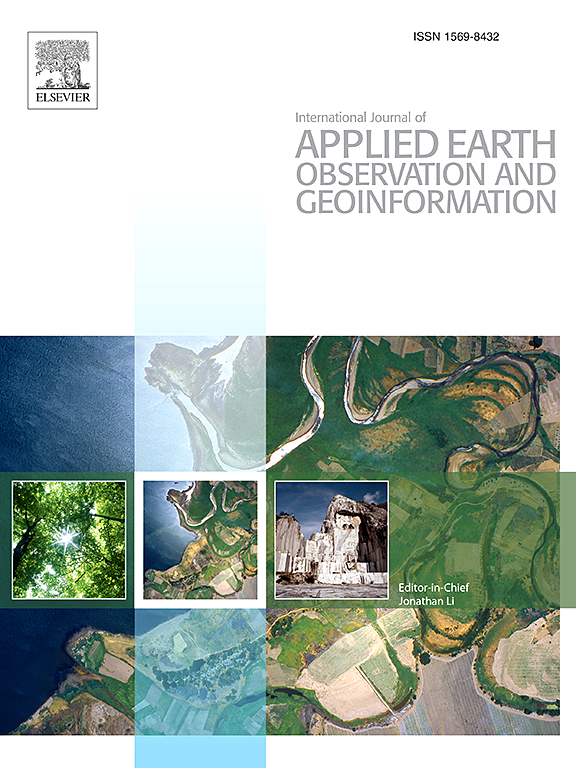泥沙负荷减少和植被恢复导致黄河水色更清澈:来自38年陆地卫星观测的证据
IF 8.6
Q1 REMOTE SENSING
International journal of applied earth observation and geoinformation : ITC journal
Pub Date : 2025-02-01
DOI:10.1016/j.jag.2025.104369
引用次数: 0
摘要
黄河是世界第五大河流,在区域发展中起着至关重要的作用,因此水质评价必不可少。遥感提供了一种快速方便的观测手段,但水质反演模型往往受到内陆水域复杂光学性质和有限原位样品可用性的限制。Forel-Ule颜色指数(FUI)与卫星数据相结合,对大规模、全面的水质评价是有效的。然而,YR的长期水色动态及其对环境变化的响应尚未得到系统的研究。利用Landsat数据建立了一种改进的色相角(α, FUI转换参数)反演模型,并对1985 - 2023年云南水色动态进行了评价。结果表明:YR的FUI总体较高,平均FUI为16.84±1.85,具有明显的季节变化和空间分布格局,受大坝建设和环境特征的影响显著。近38 a来,86.47%的河段α值呈下降趋势,其中以黄土高原最为明显。在工程措施和退耕还林政策的推动下,泥沙负荷的减少和植被的增加是造成长期水色变化的主要因素。总体而言,YR水色向绿色色调的转变是一个积极的信号,表明水质和生态系统的改善。本研究对于深入了解YR流域水质变化,为流域生态恢复和管理提供参考具有重要意义。本文章由计算机程序翻译,如有差异,请以英文原文为准。

Reduced sediment load and vegetation restoration leading to clearer water color in the Yellow River: Evidence from 38 years of Landsat observations
The Yellow River (YR), the fifth largest river in the world, plays a crucial role in regional development, making water quality assessment essential. Remote sensing provides a rapid and convenient means of observation, but water quality inversion models are often limited by the complex optical properties of inland waters and the availability of limited in-situ samples. The Forel-Ule color index (FUI), combined with satellite data, is effective for large-scale, comprehensive water quality assessments. However, the long-term water color dynamics of YR and its response to environmental changes have not been systematically studied. This study developed an improved hue angle (α, FUI conversion parameter) inversion model using Landsat data and assessed YR’s water color dynamics from 1985 to 2023. The results showed that YR’s FUI was generally high (mean FUI: 16.84 ± 1.85), with notable seasonal variation and spatial distribution patterns significantly influenced by dam construction and environmental features. Over the past 38 years, 86.47 % of river sections exhibited a declining α trend, particularly in the Loess Plateau. Reduced sediment load and increased vegetation, driven by engineering measures and the “Grain for Green” policy, were the primary factors behind long-term water color changes. Overall, the shift of YR water color towards greener hues was a positive signal, indicating improvements in water quality and ecosystem recovery. This study is significant for a deeper understanding of YR’s water quality changes and for informing watershed ecological restoration and management strategies.
求助全文
通过发布文献求助,成功后即可免费获取论文全文。
去求助
来源期刊

International journal of applied earth observation and geoinformation : ITC journal
Global and Planetary Change, Management, Monitoring, Policy and Law, Earth-Surface Processes, Computers in Earth Sciences
CiteScore
12.00
自引率
0.00%
发文量
0
审稿时长
77 days
期刊介绍:
The International Journal of Applied Earth Observation and Geoinformation publishes original papers that utilize earth observation data for natural resource and environmental inventory and management. These data primarily originate from remote sensing platforms, including satellites and aircraft, supplemented by surface and subsurface measurements. Addressing natural resources such as forests, agricultural land, soils, and water, as well as environmental concerns like biodiversity, land degradation, and hazards, the journal explores conceptual and data-driven approaches. It covers geoinformation themes like capturing, databasing, visualization, interpretation, data quality, and spatial uncertainty.
 求助内容:
求助内容: 应助结果提醒方式:
应助结果提醒方式:


